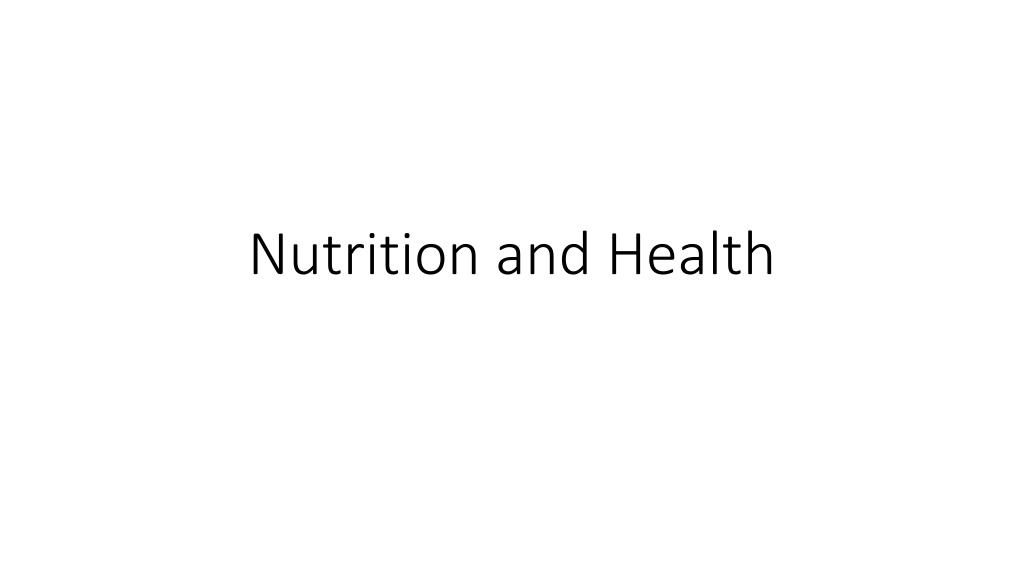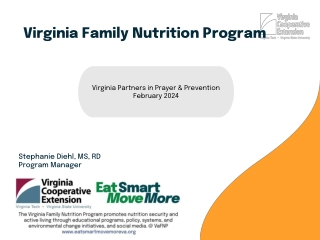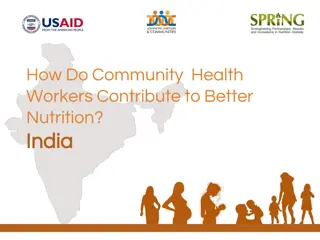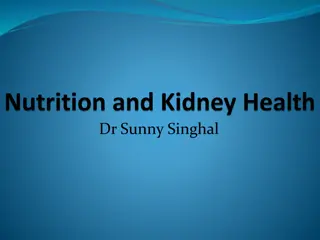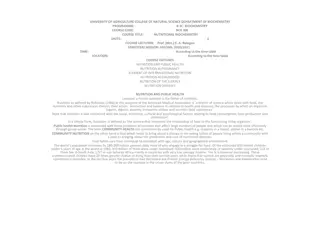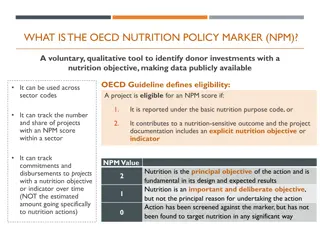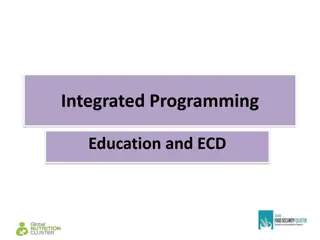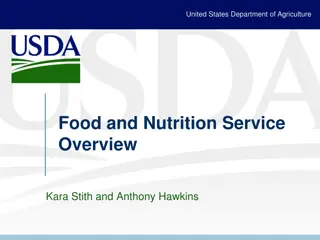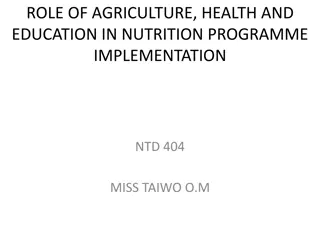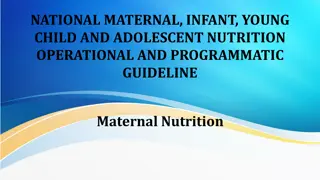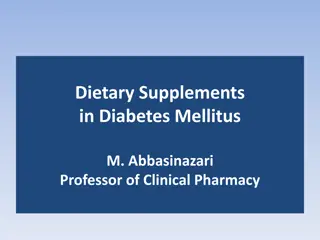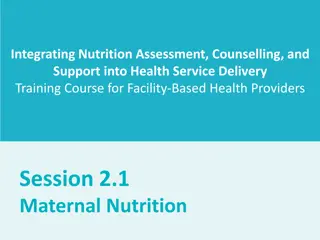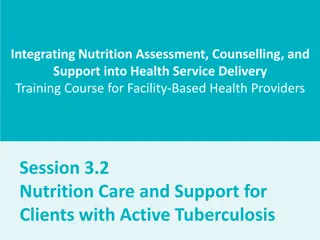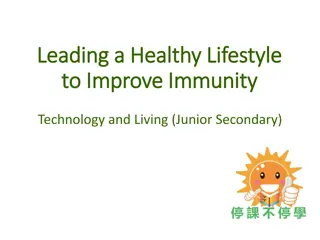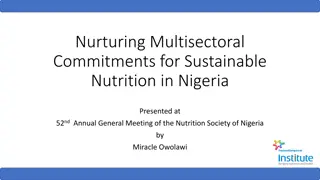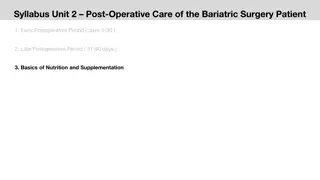Nutrition and Health: The Impact of Dietary Choices
Nutrition plays a vital role in maintaining good health. A balanced diet and regular physical activity are key to well-being, while poor nutrition can lead to various health issues. Non-communicable diseases (NCDs) like heart disease, cancer, and diabetes are primarily linked to lifestyle factors such as unhealthy diets and lack of exercise. Understanding the relationship between nutrition and disease prevention is crucial for promoting overall health and reducing the burden of NCDs globally.
Uploaded on Mar 03, 2025 | 0 Views
Download Presentation

Please find below an Image/Link to download the presentation.
The content on the website is provided AS IS for your information and personal use only. It may not be sold, licensed, or shared on other websites without obtaining consent from the author.If you encounter any issues during the download, it is possible that the publisher has removed the file from their server.
You are allowed to download the files provided on this website for personal or commercial use, subject to the condition that they are used lawfully. All files are the property of their respective owners.
The content on the website is provided AS IS for your information and personal use only. It may not be sold, licensed, or shared on other websites without obtaining consent from the author.
E N D
Presentation Transcript
NUTRITION AND HEALTH Non-communicable diseases Nutrition and HIV/AIDS
Nutrition is the intake of food, considered in relation to the bodys dietary needs. Good nutrition an adequate, well balanced diet combined with regular physical activity is a cornerstone of good health. Poor nutrition can lead to reduced immunity, increased susceptibility to disease, impaired physical and mental development, and reduced productivity.
Noncommunicable diseases (NCDs), including heart disease, stroke, cancer, diabetes and chronic lung disease, are collectively responsible for almost 70% of all deaths worldwide. Almost three quarters of all NCD deaths, and 82% of the 16 million people who died prematurely, or before reaching 70 years of age, occur in low- and middle-income countries. The rise of NCDs has been driven by primarily four major risk factors: - - tobacco use - physical inactivity - the harmful use of alcohol - unhealthy diets.
What we eat and our nutritional status can affect cardiovascular diseases, some types of cancer and diabetes . Foods, diet and nutritional status, including overweight and obesity, are also associated with elevated blood pressure and blood cholesterol, and resistance to the action of insulin. These conditions are not only risk factors for NCDs, but major causes of illness themselves. Of 52.8 million deaths worldwide in 2010, 34.5 million were due to NCDs, including cardiovascular diseases (coronary heart disease, cerebrovascular diseases such as strokes, and peripheral vascular diseases), diabetes, cancers and chronic respiratory diseases. About 80% of these deaths were in low- and middle-income countries (LMICs); 29% of these deaths were in people under age 60. Once affected, people often live with the consequences of NCDs for the rest of their lives; in 2010, NCDs contributed to 79% of illness in the world s population.
Globally, calories obtained from meat, sugars and oils and fats have been increasing during recent decades, and those from fibre-rich foods such as wholegrains, pulses and roots have been declining. Consumption of processed and convenience foods continue to rise rapidly in LMICs. This nutrition transition affects dietary patterns and nutrient intake, which influence the risk of developing NCDs. Undernutrition, and its effects on growth, development and maturation, has numerous detrimental outcomes, including the potential to increase risk of developing an NCD later in life.
Consuming predominantly plant-based diets reduces the risk of developing obesity, diabetes, cardiovascular diseases, and some forms of cancer. Plant-based diets are high in vegetables and fruits, wholegrains, pulses, nuts and seeds, and have only modest amounts of meat and dairy. These diets help to achieve and maintain a healthy weight, reduce blood pressure, and are also rich in sources of dietary fibre (which protects against colorectal cancer). Eating red and processed meat increases risk of developing colorectal cancer. Saturated fat and trans fats increase blood cholesterol and cardiovascular risk. Higher sodium/salt intake is a major risk factor for elevated blood pressure and cardiovascular diseases, and probably stomach cancer. Diets high in meat and dairy also increase blood pressure. Diets containing highly-processed foods and refined starches and/or sugary beverages contribute to overweight and obesity.
Nutrition management of obesity Obese people should follow the guidelines below in order to reduce excess weight and associated disorders and conditions. 1. Eat a variety of low energy foods from the six food groups everyday. 2. Eat unrefined foods such as whole grain bread instead of white bread 3. Eat legumes such as beans, pigeon peas, cow peas, ground beans. 4. Reduce the intake of oil rich nuts such as ground nuts, soya, and cashew nuts. 5. Eat low-fat animal foods such as meat without fat, white meat such as chicken, low fat or skimmed milk, lean fish 6. Reduce the intake of fatty foods including fat rich animal foods such as cheese, fatty beef, fatty pork, full cream milk. 7. Eat plenty of vegetables at each meal. 8. Eat plenty of fruits at each meal. 9. Eat small regular meals to avoid feeling very hungry and eating too much food. 10. Cook meals using methods that do not use fats such as roasting, grilling, boiling and steaming.
DIABETES Management of Type II diabetes (Non Insulin dependent Diabetes Mellitus) An individual with type II diabetes should observe the following guidelines in order to manage his/her condition: Take carbohydrates consistently throughout the day. Too much carbohydrates at once can raise blood glucose and too little can lead to hypoglycemia Reduce fat intake because it increases insulin resistance Use non-fat milk, meat and unsaturated fats mainly from plant origin in moderation in the diet like sun flower, soya, maize and olive oils are the best. Restrict salt intake to one teaspoon per day (to ease blood movement in the vessels). Take at least a fruit a day. These provide minerals and natural sugar Eat as much vegetables as possible for vitamins and minerals especially green and red. Examples are cassava leaves, carrots, tomato and onions among others. Avoid alcohol completely because it increases the blood sugars Eat meals consistently from day to day to improve glucose control Control weight loss and gain to avoid other complications that come due to the increase or reduction in weight Take low impact aerobic activities such as walking for 20-30 minutes at least 3 times a week. The exercise improves blood glucose control and blood lipid levels, contributes to weight loss and lowers blood pressure.
CANCER It is estimated that diet may be responsible for a third or more of all cancer cases. Stomach cancers are high in parts of the world where people eat a lot of heavily smoked, pickled or salt cured foods that produce carcinogens. Alcohol is also associated with cancer of the mouth, bladder and liver. Examples of dietary related cancers include: Oesophageal cancer, Stomach or colon cancer, Colorectal cancer, Liver cancer (Hepatitis), Breast cancer, Cervical cancer, Bladder cancer, Prostate cancer .
Dietary management of cancer Take a lot of fruits and vegetables especially green and yellow ones Take a lot of water per day, it helps to remove waste products (2- 3liters/day) Control weight and obesity (avoid becoming overweight or obese) Reduce the consumption of total saturated fats Increase fibre intake per day from whole grain foods like millet, sorghum, brown bread Minimize the consumption of salt cured, salt-pickled, and smoked foods Reduce alcoholic beverages Vary food choices
Hypertension Essential actions for preventing and managing hypertension Since hypertension is associated with several conditions including atherosclerosis, heart, kidney, stroke and eye diseases a person with hypertension should observe the following guidelines in order to prevent and manage the condition: 1. Reduce the intake of saturated fats , animal fat and caffeine (caffeine is found in tea and coffee) 2. Reduce the intake of simple sugars e.g. table sugar 3. Take complex carbohydrates such as whole grain meal like brown bread among others 4. Reduce or remove alcohol intake from your diet 5. Reduce body weight by engaging in regular physical exercise with the help of a specialist and reduce the portion size of food during meal times. 6. If overweight reduce the intake of foods such as refined carbohydrates and fatty foods.
7. Increase the intake of fruits and vegetables in your diet 8. Maintain a normal BMI which is only attained when your body weight is within the recommended one according to the standards 9. Prevent stressful situations such as overworking 10. Manage stress by giving yourself time to meditate 11. Avoid or quit smoking of any type 12. Monitor or have your blood pressure checked regularly 13. Develop the habit of using low salt diet through the use of flavours, aromas like garlic, tasty spices, tomato, and ginger when preparing meals. 14. Avoid using cooking methods that retain a lot of fats and oils in the food such as frying and stewing. 15. Follow the doctor s prescription when on medication
Nutrition and HIV/AIDS HIV/AIDS has a negative impact on nutritional status and may lead to malnutrition Malnutrition weakens the immune system and increases vulnerability to opportunistic infections Despite developments in medical treatment, nutrition remains a key component in managing this condition. The challenges that those living with HIV/AIDS face can be the result of the viral infection itself or from the effects of anti-HIV therapy (HAART) For people with HIV/AIDS, energy requirements often increase in order to maintain their regular body weight. When infected with HIV, the immune system has to work very hard to fight off infections--and this requires energy (measured in calories). For HIV-infected adults, the WHO recommended micronutrient intake comes from a good diet
Reasons for weight loss in HIV/AIDS patients HIV may reduce appetite, make food taste bad, and prevent the body from absorbing food in the right way. Some HIV medicines may also cause these symptoms Symptoms like a sore mouth, nausea, and vomiting make it difficult to eat Fatigue from HIV or medicines may make it hard to prepare food and eat regularly Opportunistic infections cause symptoms such as anorexia and fever that reduce food intake and nutrient utilization and increase nutrient requirements Reduced food intake and poor nutrient absorption weaken the immune system and hasten disease progression
Importance of adequate nutrition for PLWHA (People Living With HIV/AIDS) It prevents malnutrition and wasting Achieves and maintains optimal body weight and strength Enhances the body s ability to fight opportunistic infections May help delay progression of the disease Improves effectiveness of drug treatments Improves quality of life
Diet recommendations for PLWHA In general, the basics of a healthy diet are the same for everyone, including people with HIV. Eat a variety of foods from the five food groups: fruits, vegetables, grains, protein foods, and dairy. Eat the right amount of food to maintain a healthy weight. Choose foods low in saturated fat (found in animal products such as fatty meats, whole milk, and butter), sodium (salt), and added sugars.
